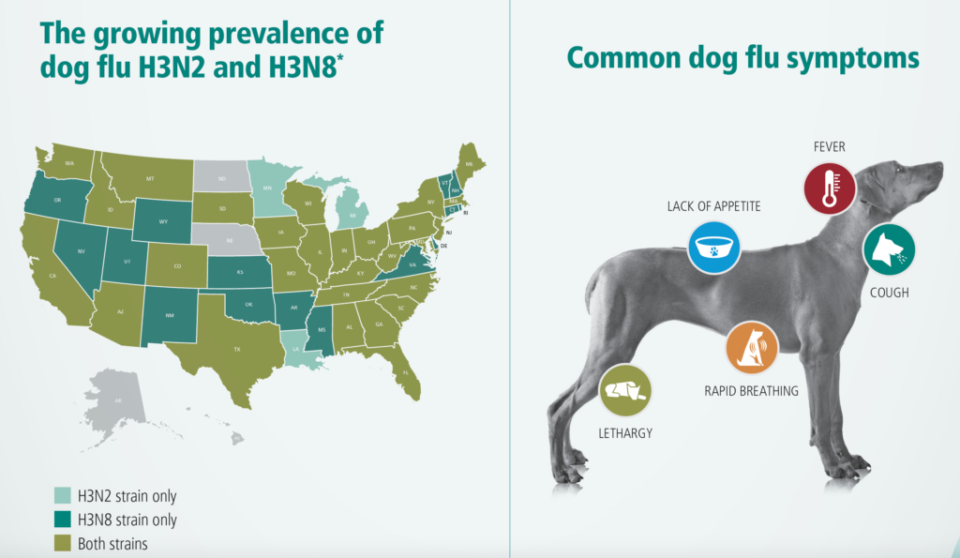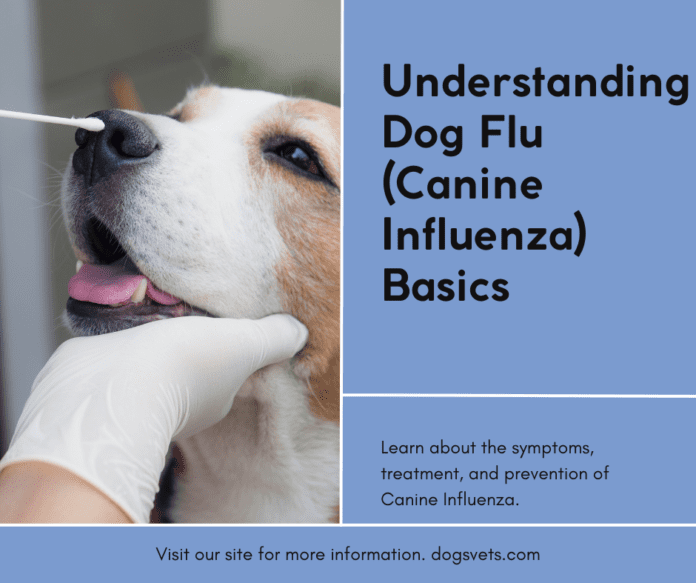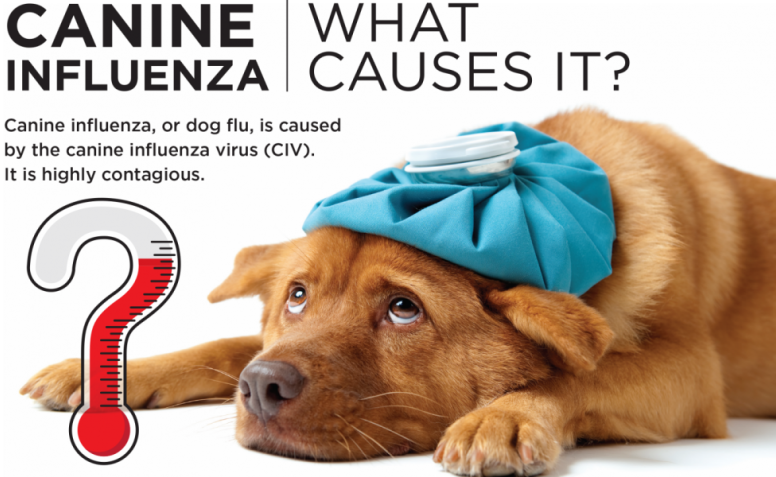Last Updated on March 25, 2024 by Dog Lover
Understanding Dog Flu (Canine Influenza) Basics
They offer us companionship, love, and an abundance of joy – our dogs are integral members of our families.
So, it is undeniably distressing when these cherished creatures fall ill. One prevalent health concern among dogs, often overlooked due to a lack of awareness, is Dog Flu or Canine Influenza.
Whether you’ve raised dogs for years or have recently brought home your four-legged friend, you’ve likely heard about canine influenza.
But how much do you actually know and understand about this contagious disease? As a committed pet parent, it’s crucial to delve into the dog flu basics and learn the fundamentals of canine influenza.
Before you jump to the conclusion that it’s similar to its human equivalent, it’s important to clarify: canine influenza and human influenza are not the same. This disease affects our pets differently and demands a unique approach to prevention and treatment.
Our connection with our pets transcends language; they understand our mood and comfort us in trying times. So, shouldn’t we strive to understand their health issues better? Bone up on your canine influenza essentials and step forward in your journey of understanding dog flu in dogs, arming yourself with knowledge to protect your furry friend.
In this article, we will explore and decode the mysteries surrounding Dog Flu.
Key Takeaways
- Dog Flu, also known as Canine Influenza, is a significant health concern for dogs.
- This disease is different from human influenza and requires a unique approach to prevention and treatment.
- Having a strong understanding of the fundamentals of canine influenza is key to preventing and managing this disease.
- Canine influenza, while contagious among dogs, is not a death sentence and can be managed with proper care and treatment.
- It’s about safeguarding their health through information, awareness, and prompt veterinary care.

What is Dog Flu (Canine Influenza)?
Also known as the canine influenza, the concept of ‘dog flu’ can be baffling for many. To keep our beloved pets safe, it becomes imperative to delve into the specifics of this condition.
The Origin and History of Canine Influenza
In the history of canine influenza, it is known to surface first around the early 2000s, mainly among racing greyhounds.
Initially, this illness was misdiagnosed as kennel cough due to similar respiratory symptoms but soon enough was identified as a virus strain similar to the equine influenza virus; termed as H3N8.
Since then, canine influenza has been a subject of rigorous studies and awareness among pet owners.
Understanding the H3N8 and H3N2 Virus Strains
The H3N8 and H3N2 virus strains form the bedrock of the dog flu landscape. Notably, the H3N8 equine influenza virus mutated to create a canine-specific strain around the early 2000s.
Subsequently, by 2007, a new type of dog flu virus, the H3N2 derived from avian species, made an appearance marking the evolution of the canine influenza history.
Remember, while both strains H3N8 and H3N2 can lead to dog flu, they can’t be transmitted to humans. This makes canine influenza distinct from the human flu virus, which is a common point of confusion.
How Canine Influenza Differs from Human Influenza
Many pet owners question if human flu and dog flu are the same. To clarify, they are not. Although both are types of influenza viruses, they are caused by different strains.
Unlike human influenza viruses, the strains causing dog flu — H3N8 and H3N2 — are not infective to humans. Understanding this distinction is a step towards comprehending what is dog flu and its implications for our pets.
Always remember, if your dog seems under the weather, don’t hesitate to consult with a vet. Awareness and early detection can make all the difference.
Symptoms of Dog Flu to Watch For
Being aware of possible symptoms of dog flu is the first step towards ensuring the health and well-being of your furry friend. The symptoms can be subtle and sometimes mistaken for other diseases, making it crucial to elevate our dog flu symptoms awareness.
Canine influenza often starts as an upper respiratory infection, presenting symptoms similar to other common respiratory diseases in dogs.
However, with appropriate attention, certain symptoms can provide a first clue about a possible dog flu infection.
Here are several identifying canine influenza signs to watch out for:
- Cough: A persistent and dry cough can be a warning sign, which can last for up to 3 weeks despite cough suppressants and antibiotics.
- Runny Nose: At the start of the illness, the nasal discharge is typically clear, but as the disease progresses, the discharge can become thick and yellowish-green.
- Fever: Dogs suffering from dog flu may exhibit fever, noticeable by hot ears and a hot, dry nose.
- Lethargy: Infected dogs often appear visibly tired, showing a lack of energy and enthusiasm for activities.
- Loss of Appetite: Refusing to eat or reduced appetite can be another sign of dog flu.
- Pneumonia: Some dogs may develop complications like pneumonia, noticeable by rapid breathing and coughing up blood.
The severity of these symptoms can vary from mild to severe, with some dogs showing severe signs while others show none at all.
Hence vigilance and prompt veterinary consultation are key to protecting your pet from this disease.
| Symptom | Explanation |
|---|---|
| Cough | A persistent and dry cough that lasts up to three weeks |
| Runny Nose | Nasal discharge that starts clear and becomes thick and yellowish-green as the disease progresses |
| Fever | Hot ears and a hot, dry nose indicative of fever |
| Lethargy | Visible tiredness, lack of energy and enthusiasm for activities |
| Loss of Appetite | Reduced appetite or refusal to eat |
| Pneumonia | Rapid breathing and coughing up blood as signs of possible pneumonia |
Understanding and being able to accurately identify these symptoms will act as a first line of defense against a potential dog flu outbreak, enabling timely intervention and preventing further health complications.

Diagnosing Dog Flu in Dogs
Correct identification of dog flu or canine influenza is critical to ensure effective treatment and management of the illness.
The diagnostic process incorporates the crucial role played by veterinarians along with specific tests employed for detection.
The Role of Veterinarians in Detection
Veterinarians play a pivotal role in diagnosing dog flu. Based on the reported symptoms and visible clinical signs, a preliminary diagnosis can be made. However, a confirmatory diagnosis often necessitates further investigation.
“Veterinarians are instrumental in detecting dog flu and differentiating it from other respiratory illnesses through specific tests to confirm the presence of the influenza virus.”
Tests Used for Diagnosing Canine Influenza
There are several tests available to diagnose canine influenza. The choice of test often depends on the stage of the disease, the dog’s clinical condition, and the veterinarian’s preference. Below is an overview of the most commonly used tests for dog flu:
| Test | Procedure | Best Used When |
|---|---|---|
| Nasal or Throat Swab | A swab is taken from the nasal or throat region and tested for influenza virus. | Conducted within the first 4 days of illness onset. |
| PCR | The polymerase chain reaction (PCR) test is performed on a nasal swab or throat swab sample. | Best suited for acute phase, typically within the first week of the infection. |
| Serology | Serology involves testing blood samples for the presence of antibodies against canine influenza. | Conducted 2 weeks after illness onset, and it is useful for confirming a previous infection. |
The chosen test for diagnosing dog flu is instrumental in determining the best treatment and management approach for the affected dog.
Treatment Options for Canine Influenza
When it comes to battling canine influenza, a broad spectrum of treatment methods offers valuable solutions.
From effective home care techniques to a rigorous regimen of dog flu medications, various remedies are available to foster your beloved pet’s swift recovery.
Let us delve deeper into the strategies optimal for managing the disease.
Home Care and Management of Sick Dogs
Prior to implementing any home care for dog flu, it’s pivotal to have a veterinarian diagnose and confirm the canine influenza. Handling an affected dog at home can significantly reduce stress and aid the healing process.
Most importantly, maintaining hydration is crucial as fever can often lead to dehydration. Offering your dog clean water frequently can help prevent this.
Equally important is a balanced diet, which supports their immune system in the battle against the illness.
Medications and Therapies for Dog Flu
Based on the severity of symptoms, veterinarians may prescribe a range of dog flu medications. Mostly, treatment for canine influenza involves supportive care. Antiviral medications can stop the virus from spreading within your dog’s body.
One commonly used antiviral for canine influenza therapy is Oseltamivir Phosphate (more commonly known as Tamiflu).
Please note that the dosage and duration of usage should be strictly supervised by a vet because misuse can lead to resistance.
| Medication/Therapy | Application |
|---|---|
| Broad Spectrum Antibiotics | Therapy against secondary bacterial infections, not effective against the virus itself |
| Fluid Therapy | Re-hydration and maintenance of hydration levels, particularly in severe cases with a lot of dehydration |
| Antiviral Medication | Prevent the spread of the virus, although not a cure |
| Nebulization | Treatment for dogs suffering from a nasal discharge or pneumonia |
| Supportive Care | Commonly includes rest, proper nutrition and maintaining hydration |
It is crucial to remember that all medicines should be administered under strict veterinary supervision, as improper use can lead to complications and delayed recovery.
Preventing Dog Flu: Best Practices
In the battle against canine influenza, preventive actions prove to be the most effective. Implementing a series of best practices can considerably lower the risk of your dog contracting this contagious respiratory disease.
From vaccinations and sanitation protocols to boosting your pet’s immune system through proper nutrition, let’s delve into the key strategies that could serve to shield your beloved pet from the grip of dog flu.
Vaccination: A Crucial Preventive Measure
Vaccination plays an indispensable role in the prevention of dog flu. The dog flu vaccination aids in curbing the severity and spread of the disease, contributing significantly to maintaining a healthy pet environment.
The two strains of dog flu, H3N8 and H3N2, have unique vaccinations. While they do not completely prevent the flu, vaccinations drastically decrease symptoms.
Consult your vet to determine the best vaccine and schedule tailored to your dog’s specific needs.
Sanitation and Quarantine Measures
Implementing effective sanitation protocols is another important preventive strategy. Regular cleaning of dog belongings and their environment can restrain the spread of the virus.
If you notice any symptoms indicative of the flu in your dog, isolating them (quarantine) from other pets could be a potential measure to curb the spread.
Regular washing of hands before and after handling your pet would also prove beneficial.
Building Immunity Through Proper Nutrition
Boosting your dog’s immunity is integral to preventing dog flu. This can be achieved by providing them with highly nutritious meals.
Proper dog immunity nutrition includes foods rich in omega-3 fatty acids, vitamins C and E, and additional supplements as advised by your vet.
These nutrients help in enhancing your dog’s immunity, keeping them robust and resilient against diseases like the canine influenza.
| Prevention Measure | Description |
|---|---|
| Vaccination | A crucial preventive measure often taken as per the vet’s advice based on the dog’s specific needs. |
| Sanitation Protocols | Include regular cleaning of dog belongings and the environment. |
| Quarantine Measures | Isolation of symptomatic pets from others to prevent virus spread. |
| Proper Nutrition | Providing a balanced diet rich in nutrients that enhance dog immunity. |
Understanding Dog Flu Vaccine
The dog flu vaccine is a crucial tool in the prevention of canine influenza. For many dog owners, it represents a first line of defense against this contagious respiratory disease.
However, deciding to administer a vaccine to your pet is not a decision to be taken lightly and requires a thorough understanding of the canine influenza vaccination specifics.
The main reason to vaccinate pets is the increasing prevalence of dog flu. Canine influenza cases are reported year-round in various parts of America.
This continual presence of the disease makes immunization for dog flu a sensible choice for most pet owners, particularly those who often take their dogs to social settings like dog parks, grooming salons, or boarding kennels, which are typical hotspots for the spread of the disease.
It’s also worth noting that the vaccine isn’t just to protect your pet; it also helps curb the overall spread of the virus.
There are two common vaccines for canine influenza available in the market: one for the H3N8 strain and another for the H3N2 strain.
Both vaccines have demonstrated their effectiveness in controlling the spread of dog flu and reducing the severity and duration of the disease when it occurs.
Note: While the dog flu vaccine can reduce the risk of your dog contracting canine influenza, it does not guarantee complete protection. Also, these vaccinations do not offer cross-protection; this means that vaccinating a dog against one strain will not protect it from the other strain.
- Consult with your veterinarian: Before deciding to vaccinate, consult with a professional. Your vet can provide information on the vaccine’s specifics and whether it’s the right choice for your dog, considering factors like age, health status, lifestyle, and the prevalence of influenza in your locality.
- Initial vaccination: If your vet decides that your dog should be vaccinated, the typical procedure includes two vaccinations given 2-4 weeks apart. This comprises an initial vaccination followed by a booster.
- Annual revaccination: An annual revaccination is typically recommended for at-risk dogs, as immunity from the vaccination decreases over time.
The following table provides a brief overview of the two common vaccines for canine influenza:
| Virulent Canine Influenza Vaccine, H3N8 & H3N2 | Canine Influenza Vaccine, H3N2 |
|---|---|
| This is a bivalent vaccine that provides active immunity against both H3N8 and H3N2 strains of canine influenza. | This vaccine is monovalent and provides immunity specifically against the H3N2 strain. |
| Commonly used for dogs older than seven weeks, compliant with lifestyle and health requirements. | Can be used in healthy dogs older than eight weeks as a preventive measure against the H3N2 strain. |
Keeping your dog protected from diseases like canine influenza is a responsibility shared by the pet owner and their veterinarian. Understanding the particulars of the dog flu vaccine is the first step in making an informed decision for the betterment of your dog’s health and wellbeing.

Canine Influenza Transmission Explained
Understanding the transmission of canine influenza is key to preventing the spread of this contagious disease.
Commonly referred to as dog flu, this illness is primarily an airborne disease, primarily transmitted when dogs come into direct contact with respiratory secretions from infected dogs.
It may also spread through sharing contaminated objects and by human hands moving between infected and unaffected dogs.
While canine influenza is highly contagious, and many dogs have not been exposed to the virus before, leading to fast spreading of dog flu in populations of unvaccinated dogs.
Understanding how is dog flu transmitted can be empowering for pet owners, as it allows them to take preventive measures and minimize their pets’ risk of contracting the disease.
“Prevention is always better than cure.”
There are several environments and behaviors that can heighten a dog’s chance of coming into contact with canine influenza virus:
- Dog parks, kennels, pet stores, and any places where dogs gather can be hotspots for spreading of dog flu.
- Close contact with an infected dog, particularly when the dog is coughing or sneezing, can easily transmit the virus.
- Some dog breeds may be more susceptible than others, such as brachycephalic breeds that have a short nose and flat face.
Knowing canine influenza transmission routes, pet owners can safeguard their pets by avoiding environments where the infection might be present, or by ensuring their pets are vaccinated against the virus.
Furthermore, practicing good hygiene, such as frequent hand washing and cleaning of pet toys, can also help manage the spreading of dog flu.

Risks of Dog Flu to Specific Dog Populations
As we delve into the specific risks associated with dog flu, it is important to note that certain groups of dogs, such as puppies and elder canines, are more susceptible to severe complications of this disease.
Furthermore, the social nature of some dog environments, such as kennels and shelters, enhances the transmission of canine influenza, leading to the potential for outbreaks.
Puppies and Elder Dogs: A Closer Look at Vulnerability
Puppies and elder dogs bear the brunt of dog flu risks due to their weakened or underdeveloped immune systems.
The occurrence of canine influenza in puppies can interfere with their normal growth and development while elder dogs may experience complications due to existing health conditions.
| Age Group | Risk Factor for Dog Flu |
|---|---|
| Puppies | Underdeveloped immune systems and lack of previous exposure. |
| Elder Dogs | Weakened immune system, presence of other potential health conditions. |
The Impact of Canine Influenza in Kennels and Shelters
The threat to dogs living in close quarters significantly escalates the seriousness of the scenario, amplifying the dog flu impact on kennels and shelters.
An outbreak of canine flu in such locations spreads swiftly, potentially affecting a large number of dogs in a short time frame.
This makes kennels and shelters high-risk environments prone to an intensified spread of the disease, necessitating higher levels of preventive measures for canine influenza control.
In conclusion, understanding the risk of dog flu in specific populations and areas enables us to build effective response strategies, thereby enhancing the overall health and well-being of our canine companions.
Conclusion
In this detailed overview, we’ve explored the various facets of canine influenza, popularly known as dog flu.
This contagious respiratory disease affects our beloved canine friends, and as pet owners, it is our responsibility to ensure their health and wellbeing.
Understanding, preventing, and managing dog flu is not just about improving our pets’ lives but also securing their future.
Recap of Dog Flu Prevention and Management
The first line of defense against canine influenza is prevention, underscored by responsible pet ownership that includes regular vaccinations. As we have discussed, vet-prescribed vaccines play a crucial role in curbing the spread of dog flu.
However, along with regular vaccinations, maintaining sanitation is also paramount.
As part of dog flu management, if a pet does catch the illness, timely diagnosis and appropriate treatment using recommended medications help the pet recover faster.

Encouragement for Pet Owner Vigilance
Pet owners have an immense role in managing canine influenza. If your dog shows symptoms of dog flu, consult with your veterinarian without delay.
Each pet owner has a responsibility to not only take care of their pets but also help prevent the spread of this disease.
Through vigilance, continuous education, and appropriate actions, we can reduce the risk of our pets contracting dog flu and ensure they lead a healthy, carefree life.
Remember, our pets’ health is not just about treating diseases; it is about preventing them. With your informed efforts and continuous learning about canine health, we, as a society of pet owners, can make a significant difference in managing canine influenza.
FAQ
What is canine Influenza?
Canine influenza, also known as dog flu, is a contagious respiratory disease in dogs caused by specific Type A influenza viruses, mainly H3N8 and H3N2.
How is canine influenza different from human influenza?
Although both are respiratory diseases caused by influenza viruses, they are caused by different strains. Canine influenza can not be transmitted to humans, however, in rare cases, it can be transmitted from dogs to cats.
What are the symptoms of dog flu?
Typical symptoms include cough, runny nose, fever, lethargy, eye discharge, and reduced appetite. These symptoms are similar to other respiratory diseases in dogs and thus a veterinary examination is required for a correct diagnosis.
How can the dog flu virus be detected?
Veterinarians typically use polymerase chain reaction (PCR) tests or antibody testing to detect and confirm cases of canine influenza. Lab samples for these tests include nasal or oral swabs for PCR tests, and blood samples for antibody tests.
What treatment options are available for canine influenza?
While there is no specific treatment for canine influenza, supportive care often helps to manage the symptoms. This could include ensuring proper hydration, nutrition, and resting for the dog. In some cases, antibiotics may also be prescribed to deal with secondary bacterial infections.
How can dog flu be prevented?
Regular vaccination is the most effective way to prevent canine influenza. Additionally, maintaining good hygiene habits, feeding a balanced diet, and minimizing contact with infected dogs also helps in prevention.
What is dog flu vaccine?
The dog flu vaccine is a preventive measure that helps to protect dogs from both H3N8 and H3N2 strains of the influenza virus. Consult your veterinarian to determine the right vaccination schedule for your pet.
How is dog flu transmitted?
The dog flu virus spreads through the air, direct contact with infected dogs, or surfaces contaminated by respiratory secretions. Areas with high dog population like kennels, dog parks, and pet shops pose a larger risk of transmission.
Are some dog populations more susceptible to the disease?
Yes, puppies, elderly dogs, or dogs with weakened immune systems can be more susceptible to canine influenza. Also, dogs living or spending time in crowded housing conditions like shelters or kennels are at a higher risk of getting infected.
Reference Links:
American Kennel Club (AKC): Canine Influenza
-
https://www.akc.org/expert-advice/health/canine-flu-highly-contagious/ This webpage by the American Kennel Club provides a comprehensive overview of canine influenza, including causes, symptoms, diagnosis, treatment, prevention, and information on different flu strains.
-
Cornell University College of Veterinary Medicine: Canine Influenza
https://www.vet.cornell.edu/animal-health-diagnostic-center/veterinary-support/disease-information/canine-influenza-virus This resource from Cornell University’s College of Veterinary Medicine offers detailed information on canine influenza, including transmission, diagnosis, treatment options, and preventative measures like vaccination. -
World Small Animal Veterinary Association (WSAVA): Canine Influenza
https://www.cdc.gov/flu/other/canine-flu/keyfacts.html
The World Small Animal Veterinary Association (WSAVA) offers a global perspective on canine influenza. This webpage provides information on the disease’s impact and recommendations for veterinarians.



















